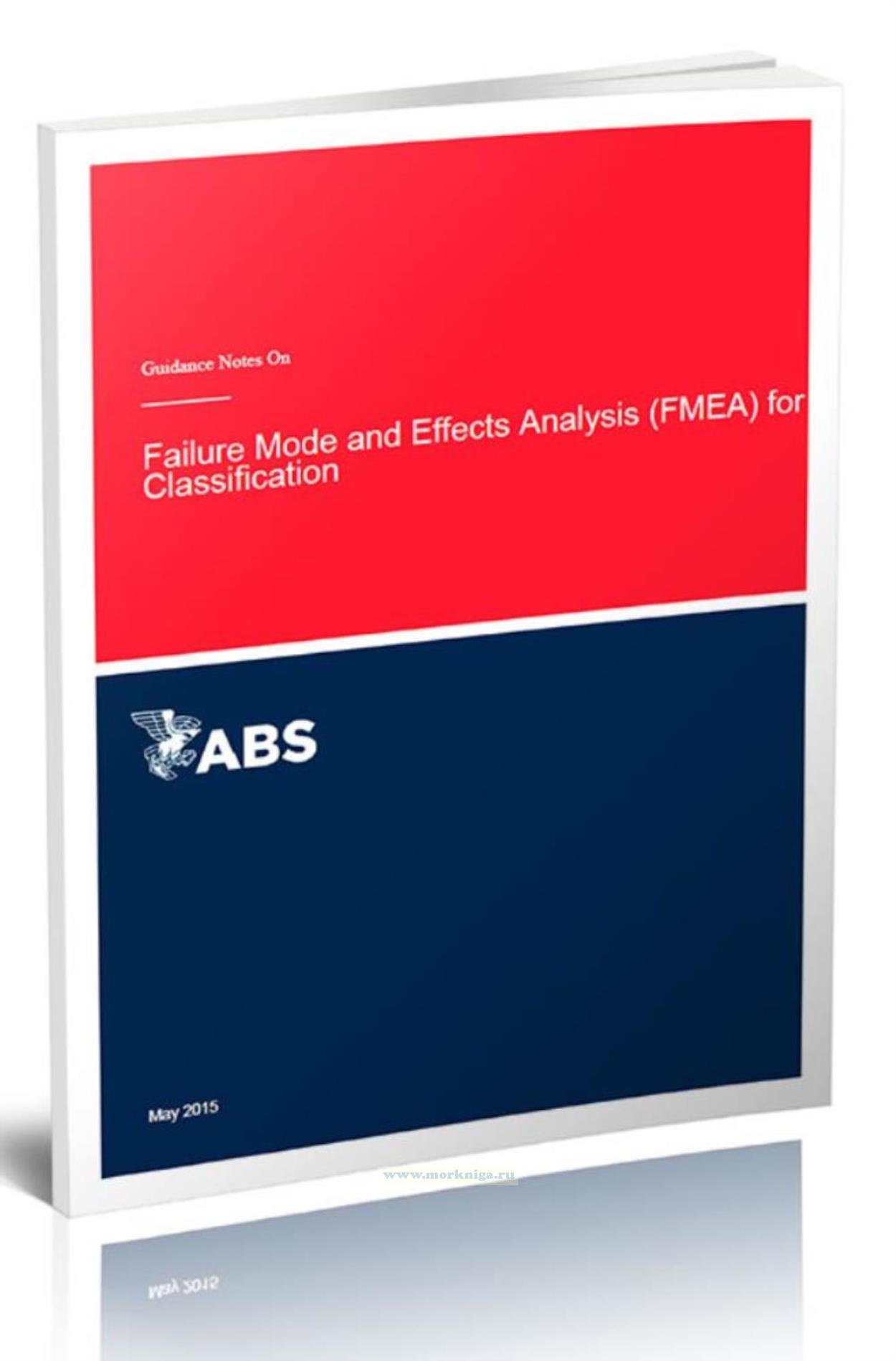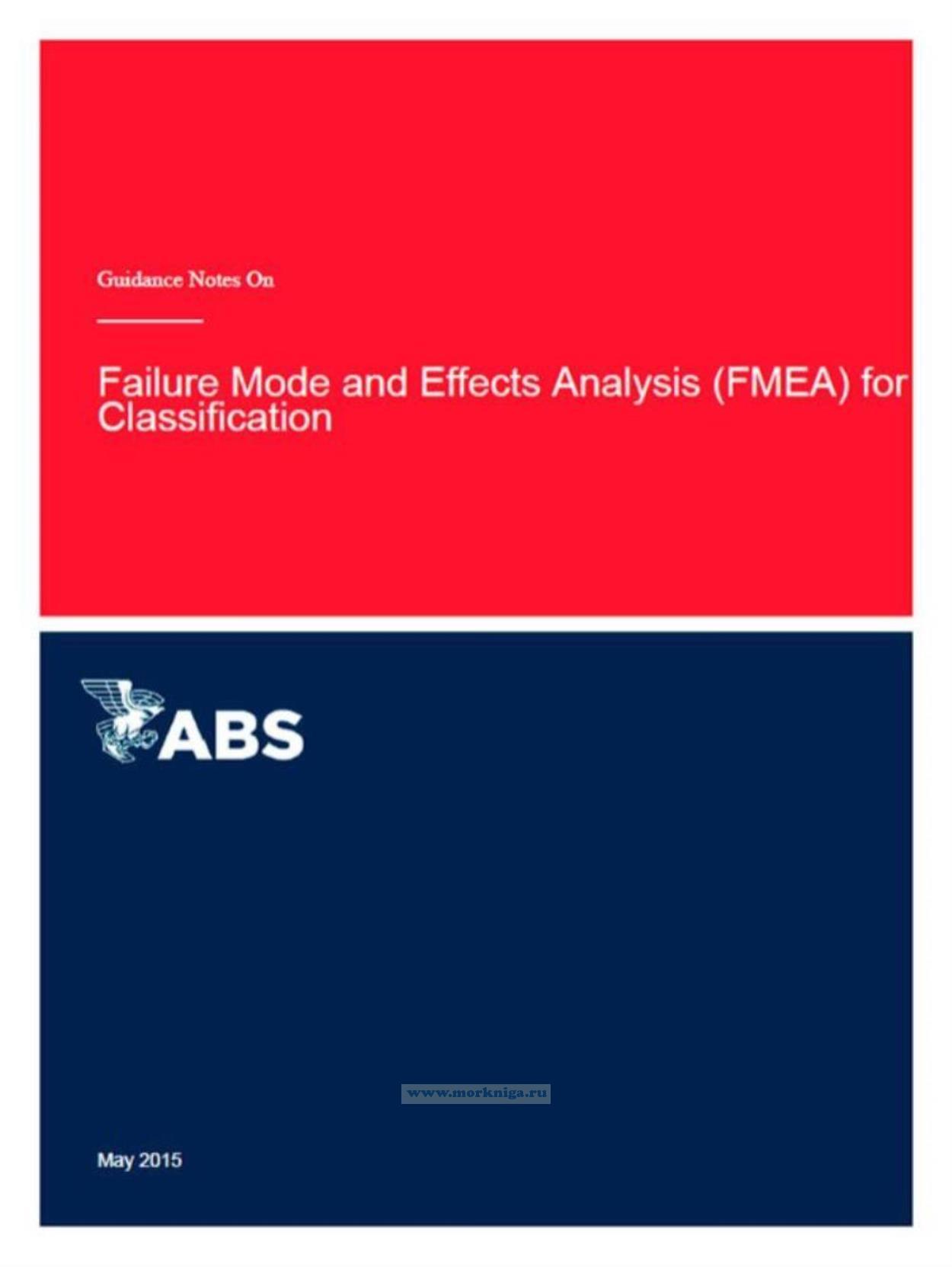Guidance Notes On Failure Mode and Effects Analysis (FMEA) for Classification/Руководство по классификации отдельных систем методом анализа видов и последствий отказов
Книга на английском языке.
ABS requires clients to develop and submit FMEAs as part of Classification requirements for select systems. For instance, FMEAs are required for achieving many of the special or optional Classification notations such as CDS, ACC, ACCU, R1, RQ, DPS-2, DPS-3, ISQM. This document provides guidance and insight into the development process for FMEAs to comply with ABS Classification rule requirements. The utilization of this guidance will provide tangible benefits as the marine and offshore industry is able to realize the positive results of FMEAs that are developed correctly and managed appropriately throughout the lifecycle of a system.
The information presented herein is intended solely to assist the reader in the methodologies and/or techniques discussed. These Guidance Notes do not and cannot replace the analysis and/or advice of a qualified professional. It is the responsibility of the reader to perform their own assessment and obtain professional advice.
Contents
Section 1 Introduction
1 Background
2 Purpose of FMEAs
3 FMEA Overview
3.1 FMEA Process in a Nutshell
Table 1 Index of System-Specific Guidance for ABS FMEA Requirements
Figure 1 Process Flow for Classification Required FMEAs
Section 2 Before the FMEA
1 Preparing for the FMEA
1.1 FMEA Standards
1.2 Design Philosophy and FMEAs
2 FMEA Scope and Ground Rules
2.1 Equipment Scope and Physical Boundaries
2.2 Operational Boundaries (Global and Local)
2.3 Failure Criteria and Types of Failure
2.4 Depth of Analysis
2.5 Criticality Ranking (FMECA)
2.6 FMEA Naming Convention within this Document
2.7 US Coast Guard Supplemental Requirements for Qualitative Failure Analyses (QFA)
3 FMEA Team
3.1 Stakeholder’s Workshop Setting
3.2 Third-Party FMEA Practitioner(s)
3.3 ABS Participation in the FMEA Workshop
3.4 Team Preparation
4 Ideal Timing to Conduct FMEAs
Table 1 Typical Corrective Actions to Control Failure Scenarios
Table 2 Examples of System/Subsystem’s Physical Boundaries (for a DP System)
Figure 1 Typical Risk Matrix for FMECA
Section 3 Developing the FMEA
1 Developing the FMEA
2 Data Management
2.1 Data Collection to Support the Analysis
2.2 Other Risk Analysis as Input to the FMEA
2.3 Data Analysis
3 FMEA Study
3.1 Define the Analysis
3.2 Develop the Analysis Approach
3.3 Identify Failure Modes
3.4 Analyze Effects
3.5 Identify Failure Detection Methods
3.6 Identify Existing Risk Control Methods
3.7 Criticality Ranking (for FMECA)
3.8 Identify Corrective Actions
Table 1 Risk Analyses that could Provide Input Information to an FMEA
Table 2 Sample FMEA/FMECA Worksheet
Table 3 Sample Failure Modes of Mechanical and Electrical Components
Figure 1 FMEA Study Flowchart
Figure 2 Reliability Block Diagram (or Dependency Diagrams)
Figure 3 Example of External/Operational Forces That May Impact FMEA Study
Section 4 FMEA Report and Classification Review of FMEA
1 FMEA Report
1.1 Report Structure
1.2 FMEA Internal Review Process
2 Classification Review of the FMEA
2.1 Pitfalls and Common Problems in Classification Submitted FMEA
2.2 FMEA and Supporting Documentation Submittal
Table 1 Sample FMEA Report Structure
Figure 1 Sample Cause and Effect Matrix
Section 5 FMEA Verification Program
1 Purpose
1.1 Scope of FMEA Verification Program
1.2 Verification Program Test Sheets
1.3 Performing FMEA Verification Program
1.4 Results and Recommendations
1.5 FMEA Verification Program Report
1.6 United States Coast Guard Design Verification Test Procedure
Table 1 Sample FMEA Verification Program Report Structure (for a DP FMEA)
Figure 1 FMEA Trial Test Sheet Example
Section 6 FMEA Lifecycle Management
1 Best Practices for FMEA as a Living Document
1.1 Best Practices for FMEA as an Operations Resource Document
1.2 Best Practices for FMEA Lifecycle Management
1.3 Changes to the Classed System and FMEA Revisions and Submittals
1.4 FMEA and Management of Change
Table 1 Suggested Entries in Management of Change Form for FMEAs
Figure 1 FMEA Lifecycle Management
Section 7 System-Specific FMEA Requirements
1 Guidance for System-Specific FMEA Requirements
1.1 Automation (General Control, Safety-Related Functions of Computer-Based Systems, Wireless Data Communication, Integrated Automation Systems)
1.2 Electronically Controlled Diesel Engines
1.3 Remote Control Propulsion [Automatic Centralized Control (ACC), Automatic Centralized Control Unmanned (ACCU), Automatic Bridge Centralized Control Unmanned (ABCU)]
1.4 Gas Turbine
1.5 Redundant Propulsion and Steering
1.6 Single Pod Propulsion
1.7 Dynamic Positioning Systems (DPS)
1.8 Software Control System
1.9 Jacking Systems
1.10 Subsea Heavy Lifting
1.11 Drilling Systems/Subsystems/Individual Equipment
1.12 Integrated Drilling Plant
1.13 Dual Fuel Diesel Engines (DFDE)
1.14 Gas-Fueled Engines
1.15 Motion Compensation and Rope Tensioning Systems for Cranes
Table 1 Index of FMEA Requirements in ABS Rules and Guides
Table 2 Structure of the Guidance for Each FMEA Requirement
Table 3 Sample DP FMEA Worksheet Template
Appendix 1 Definitions, Acronyms and Abbreviations
1 Definitions
2 Acronyms and Abbreviations
Appendix 2 Sample FMEA/FMECA Worksheets
1 Sample FMEA/FMECA Worksheets
1.1 FMECA Worksheet Example (for ISQM and for CDS)
Table 1 Example of BOP Control Functional Items
Table 2 FMECA Worksheet Example (Select Sections of a FMECA for BOP Control System)

